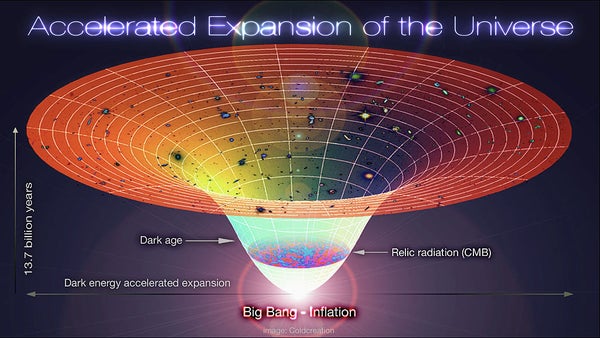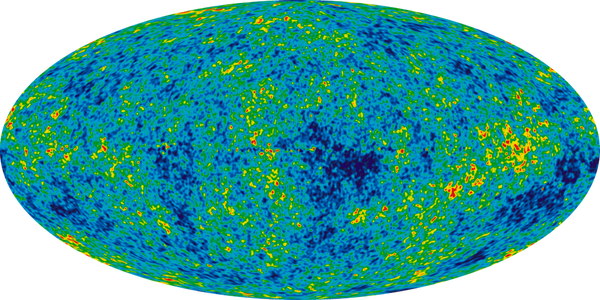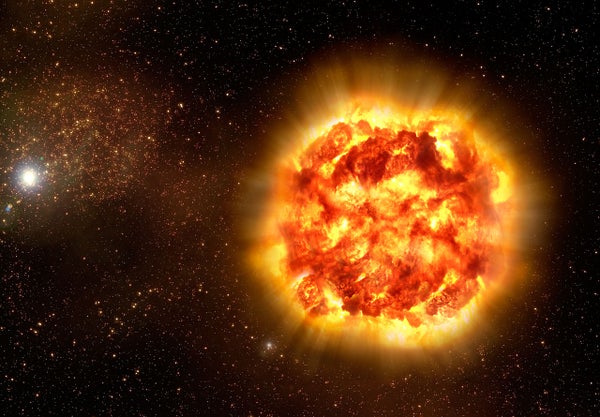This article was published in Scientific American’s former blog network and reflects the views of the author, not necessarily those of Scientific American
This week, a number of media outlets have put out headlines like "The universe is expanding at an accelerating rate, or is it?” and “The Universe Is Expanding But Not At An Accelerating Rate New Research Debunks Nobel Prize Theory.” This excitement is due to a paper just published in Nature’s Scientific Reports called "Marginal evidence for cosmic acceleration from Type Ia supernovae,” by Nielsen, Guffanti and Sarkar.
Once you read the article, however, it’s safe to say there is no need to revise our present understanding of the universe. All the paper does is slightly reduce our certainty in what we know—and then only by discarding most of the cosmological data on which our understanding is based. It also ignores important details in the data it does consider. And even if you leave aside these issues, the headlines are wrong anyway. The study concluded that we’re now only 99.7 percent sure that the universe is accelerating, which is hardly the same as “it’s not accelerating.”
The initial discovery that the universe is expanding at an accelerating rate was made by two teams of astronomers in 1998 using Type Ia Supernovae as cosmic measuring tools. Supernovae—exploding stars—are some of the most powerful blasts in the entire cosmos, roughly equivalent to a billion-billion-billion atomic bombs exploding at once. Type Ia’s are a special kind of supernova in that, unlike other supernovae, they all explode with just about the same luminosity every time likely due to a critical mass limit. This similarity means that the differences in their observed brightness are almost entirely based on how far away they are. This makes them ideal for measuring cosmic distances. Furthermore, these objects are relatively common, and they are so bright that we can see them billions of light years away. This shows us how the universe appeared billions of years ago, which we can compare to how it looks today.
On supporting science journalism
If you're enjoying this article, consider supporting our award-winning journalism by subscribing. By purchasing a subscription you are helping to ensure the future of impactful stories about the discoveries and ideas shaping our world today.

Graphic representation of cosmic acceleration caused by dark energy. Credit: Design Alex Mittelmann, Coldcreation via Wikimedia Commons under Creative Commons license
These supernovae are often called “standard candles” for their consistency, but they’re more accurately “standardizable candles,” because in practice, their precision and accuracy can be improved still further by accounting for small differences in their explosions by observing how long the explosion takes to unfold and how the color of the supernovae are reddened by dust between them and us. Finding a way to do these corrections robustly was what led to the discovery of the accelerating universe. .
The recent paper that has generated headlines used a catalog of Type Ia supernovae collected by the community (including us) which has been analyzed numerous times before. But the authors used a different method of implementing the corrections—and we believe this undercuts the accuracy of their results. They assume that the mean properties of supernovae from each of the samples used to measure the expansion history are the same, even though they have been shown to be different and past analyses have accounted for these differences. However, even ignoring these differences, the authors still find that there is roughly a 99.7 percent chance that the universe is accelerating—very different from what the headlines suggest.

The cosmic microwave background radiation, emitted a few hundred thousand years after the Big Bang, provides an independent line of evidence for the accelerating universe. Credit: NASA/WMAP Science Team via Wikimedia Commons
Furthermore, the overwhelming confidence astronomers have that the universe is expanding faster now than it was billions of years ago is based on much more than just supernova measurements. These include tiny fluctuations in the pattern of relic heat after the Big Bang (i.e., the cosmic microwave background) and the modern day imprint of those fluctuations in the distribution of galaxies around us (called baryon acoustic oscillations). The present study also ignores the presence of a substantial amount of matter in the Universe, confirmed numerous times and ways since the 1970’s, further reducing the study confidence. These other data show the universe to be accelerating independently from supernovae. If we combine the other observations with the supernova data, we go from 99.99 percent sure to 99.99999 percent sure. That’s pretty sure!
We now know that dark energy, which is what we believe causes the expansion of the universe to accelerate, makes up 70 percent of the universe, with matter constituting the rest. The nature of dark energy is still one of the largest mysteries of all of astrophysics. But there has been no active debate about whether dark energy exists and none about whether the universe is accelerating since this picture was cemented a decade ago.
There are now many new large surveys, both on the ground and in space, whose top priority over the next two decades is to figure out exactly what this dark energy could be. For now, we have to continue to improve our measurements and question our assumptions. While this recent paper does not disprove any theories, it is still good for everyone to pause for a second and remember how big the questions are that we are asking, how we reached the conclusions we have to date and how seriously we need to test each building block of our understanding.

This figure shows regions of confidence for the state of our Universe in terms of its fractions of matter and dark energy. Purple is supernova data alone, green is the CMB data alone, and black is BAO and CMB together. A vertical line shows the minimum amount of matter in the Universe derived from a multitude of cosmological probes. A line is drawn across the figure that separates models in which we live in an accelerating universe or a decelerating universe. Another line indicates a geometric flat Universe as strongly indicated by the CMB. An empty universe, where there is little or no matter or dark energy shown in the bottom left of the figure, is the focus of the recent paper by Nielsen, Guffanti and Sarkar. From SN data alone it is very likely that the Universe is accelerating. This conclusion becomes much stronger when considering any one of following: the minimum mass constraints, the CMB, or BAO and of course all of these. We see no compelling reason to neglect any of these data.
